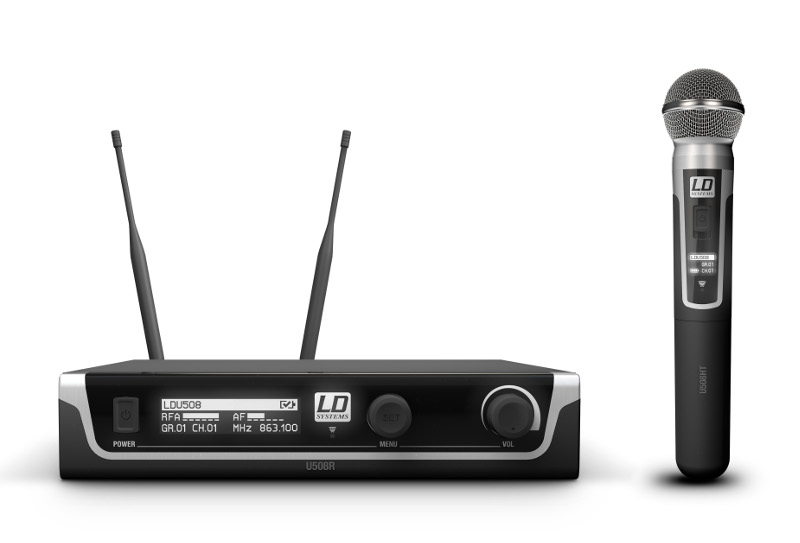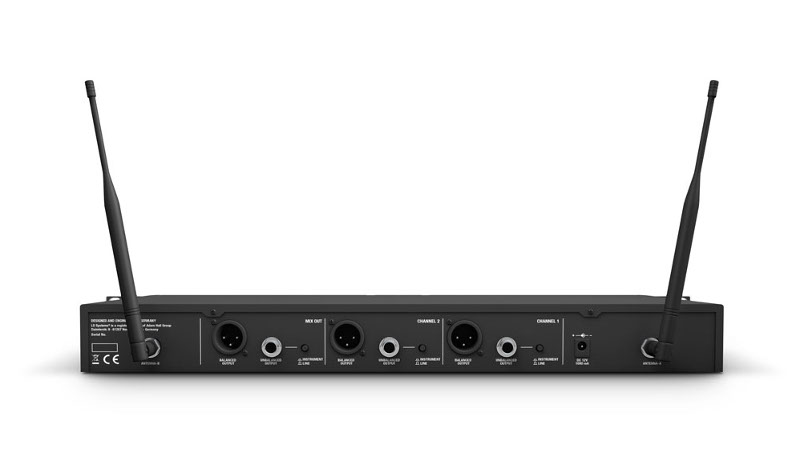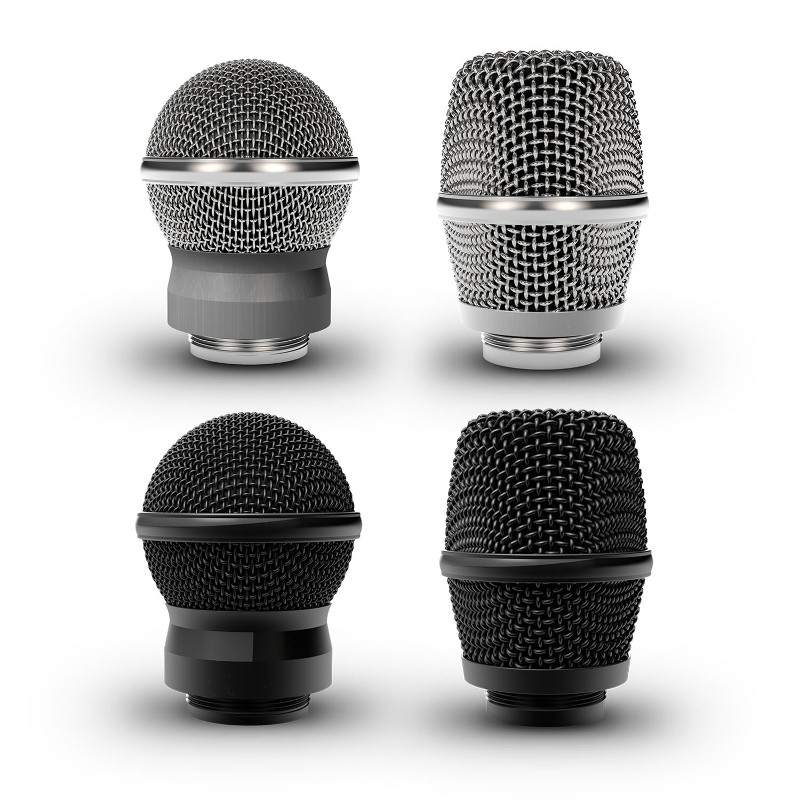The people’s wireless system: Price-performance champion LD Systems U500
With its U500 wireless system which featured at the 2016 Musikmesse, LD Systems provides a professional, flexible and affordable solution for the wireless transmission of audio signals in Germany, utilising licence-free UHF frequency bands. We have summarised below how well the U500 series performed in our extensive practical testing.

At the 2016 Musikmesse, LD Systems first presented its new professional wireless series U500, which, due to its elegant and functional appearance, has now been nominated for the German Design Award 2017. But the U500 series’ beauty is not just skin-deep. When compared to similar systems, its technical specifications impress every musician, and at an excellent price-performance ratio. We put this new wireless system from the house of LD Systems to the test in our test studio. There is something for everyone. With its new U500 series, LD Systems provides the perfect wireless system for every requirement. The U508 model in particular can be used on three licence-free UHF radio frequency bands in Germany. The model number differs depending on the corresponding frequency band:
• U505 model = 584-608 MHz (max. 12 systems simultaneously)
• U506 model = 655-679 MHz (max. 12 systems simultaneously)
• U508 model = 823-832 MHz + 863-865 MHz (max. 6 systems simultaneously).
The receiver unit can be supplied as either a single- or double-receiver, whereby the double-receiver is installed in a 1U 19” rack housing. The appropriate rack mount brackets for installation of the single-receiver in a 19” rack are available separately. The matching transmitter is available in three different versions: a hand-held microphone with a total of four different interchangeable microphone capsules, a body-pack transmitter with connection options for headset microphone, wind instruments, lavalier microphone or guitar cable. An extensive range of accessories including an antenna splitter, a directional antenna for increased range and much more, completes the new U500 wireless system.
The different microphone capsules, the body-pack transmitter with its associated microphone solutions, and the instrument cable are included with some sets. With other sets these are optional, but available separately in any case. In this way your U500 system can be set up to be flexible, and spares are available if necessary, should anything be lost or damaged. Overall, with its U500 series, LD Systems has created a well-thought-out modular and highly flexible wireless system which can be practically adapted to meet all imaginable requirements.
The receiver unit
Before we focus on the actual product test, let us first of all examine the candidates a little more closely. Our system was supplied delivered in an extremely robust black plastic case, which was protected by a relatively thin, four-colour printed outer box. After opening the two catches, the lid lifts to reveal the receiver, lying safely stored in a rigid foam bed. Now we remove the double receiver unit in its elegant and rugged-looking 19” 1U housing. Underneath, in a second layer, the two hand-held microphones, the antennas, the power supply for the receiver as well as all other accessories can also be found in corresponding cut-outs in a rigid foam bed. The necessary batteries, a quarter-inch jack patch cable and all of the components required to position the antennas at the front are included. Other manufacturers tend to charge extra for these accessories and could learn from this example.
For our test setup, we simply installed the two antennas on the back of the receiver, without using the supplied extension. We would like to mention in particular that there are two True Diversity receivers which share the the two antennas. The True Diversity design actually means that there are four receivers, because there are two separate operating receivers installed in each receiver unit. Only after the signal has been processed through both receivers from each respective system does it decide which of the two received signals is better and thus is processed further. True Diversity technology is really only found in more expensive wireless systems, because having two receivers each with separate antennas is obviously more expensive than having only one. Due to the two antennas and therefore the different angles to the transmitter unit, drop-out or temporary weakening of the signal, caused for example by a stand or a traverse directly in the radio-signal path, are prevented. For this reason, the single-receiver also has two antennas, because it too features True Diversity technology! Because, for the reasons stated, the two antennas should be placed as far apart as possible, it is recommended that single receivers, and receivers in general are installed in a rack, that the antenna is positioned at the front, and that nothing stands directly in the radio-signal path.
On the left-hand side of the receiver’s front panel we find the on/off switch, which operates both units simultaneously, and when pressed briefly, returns us to the main menu. The two identical, three-line OLED displays are very easy to read and after being switched on, display a friendly “Welcome” greeting. It then automatically switches to the three-line main display, showing the configurable user name and battery status of the associated transmitter at the top on the left. In the middle row, to the left of the letters “RF”, we see the active antenna (A or B) with the quality/strength of the radio signal, and to the right we see the volume of the audio signal, which is limited by the letters “PK” for “peak” on the far right. The left-hand side of the bottom row shows the frequency group and the configured radio channel. The right-hand side displays information about the exact radio frequency in MHz. The rotary-and-push-controls for the menu and audio signal volume are situated to the right of the displays on both receiver units. If you turn the knob for volume, the display switches automatically to an adjustment scale from 0 to 100, then returns to the main display after 3 seconds of inactivity. The infrared-interface for synchronising the relevant system settings of the receiver with the transmitter (e.g. transmission frequency) is situated centrally between the two receivers. Where the on/off switch is located on the left-hand receiver, a 6.3 mm headphone jack socket and the associated volume control for the headphone signal are located on the right-hand receiver. The front panel is bound at the sides by the two pre-drilled mounting positions for the antennas and screw holes for rack installation.

A real help for instrumentalists in addition to the connection socket for the supplied external power supply and the BNC connectors for the two antennas A and B, (which should be positioned in a “V” shape for optimal reception) there are three groups of XLR and 6.3-mm jack output sockets as well as a switch for each group. Whilst a balanced line signal is always present at the XLR output jacks, and can be sent, for example, directly to the input of the mixer via the stagebox, the unbalanced output signal from the 6.3-mm jack sockets can be optimised via the Instrument/Line switch, so that its level and impedance are suitable for example, for the input of a guitar amplifier.
But that’s not all: As a guitarist, you usually always have at least two instruments on the stage, because we all know how easy it is to break a string during a performance. Quite apart from the fact that you often simply want to be flexible regarding sound or tuning. If you are using a wireless system for the guitar, when changing guitars, you also have to transfer the wireless transmitter from one guitar to the other. Not if you use the LD Systems U500 double receiver! In addition to the individual channel outputs, the double receiver also features a mix output, which combines the audio signals from both receivers and then delivers them to an amplifier input via the Instrument/Line switch and the 6.3-mm jack. This means that if it is attached to your belt, for example, each of the two guitars can have its own transmitter which, during the show, is always connected to the corresponding receiver. In the event of a guitar change, now you only need to change the guitar and the associated transmitter on your belt, nothing else! Both guitars are continuously connected to the input of the guitar amp via the mix output. No changing of cables and therefore also no crackling in the amp. It could not be more convenient or graceful!
Hand-held microphone with transmitter
In order to make the hand-held microphone operational, which in our case was equipped with a dynamic capsule with cardioid characteristic, we first need to install the two supplied AA batteries. To do this, we rotate the base of the microphone stem to the left and remove it. After inserting the batteries we activate the transmitter with the on/off switch. On the rear of the battery compartment, we find the SEL and arrow buttons, with which we can navigate through the individual menu points and adjust the settings. The built-in OLED display always shows us where we are. Once all of the necessary adjustment of settings has been completed, we close the battery compartment by inserting it and rotating it to the right. Now we place the microphone’s infrared receiver about 10 cm from the receiver’s IR transmitter, and start the menu item “IR Sync Run” on the receiver in order to transfer all settings from the receiver to the microphone. Now we are ready to go.
The body-pack transmitter is activated in the same way. The entire process as well as various other functions such as automatic frequency scanning are described in detail in the enclosed operating instructions. The operating instructions can also be downloaded from the LD Systems website as a PDF file. The entire system is clearly structured and self-explanatory. An experienced wireless system user may not even have to use the operating manual. If you you lose your way whilst scrolling through the menu, a short touch of the power button brings you back to the main display view.

The practical test
In order to really assess the sound quality, we connected the double receiver via its balanced mix-output to our Soundcraft studio mixer, to which an active Adam Hall studio monitor system with subwoofer was connected. The monitor system has a virtually linear frequency response from 25 to 35,000 Hz. For our test we started with all EQs set flat. After switching on the U500 double-receiver and the pairing of the two hand-held microphones via the IR interface, the system was ready for testing. After activating the pilot tone and noise reduction, the system is completely free from noise. Furthermore, the noise reduction worked so sensitively and so quickly that during the speech test there was absolutely no impairment, such as the beginning of a word being cut off, for example. The sound of the voice was natural and completely without audible frequency inefficiencies or other tonal colourations. This was particularly true for the low frequencies, where the proximity effect may occur. Also pleasing was the low feedback-sensitivity of the system, which remained constant, even at relatively high volumes.
Recommended application
With its U500 wireless series, LD Systems has definitely succeeded in providing high quality, modern True Diversity UHF wireless technology in an attractive package – and at a very attractive price. The variety of different components makes the U500 system extremely flexible and suitable for stage musicians. Due to its extremely simple and pleasantly intuitive controls, and thanks to its rugged construction, this radio system is also suitable for professional PA hire. With its U500 series, LD Systems has once again proved that professional wireless technology does not necessarily have to be expensive!
Technical data:
– Device type: Wireless system for vocals and instruments
– Frequency response: 30-16,000 Hz
– Radio frequencies: 584-608 MHz and 655-679 MHz (max. 12 systems) 823-32 MHz and 863-865 MHz (max. 6 systems)
– Transmit power: up to 30 mW (corresponds to over 100 m range)
– Receiver: True Diversity UHF receiver, special features: Receiver
– Output switchable between line and instrument level, pilot tone facility and noise reduction
– Handheld microphone: Microphone capsule interchangeable with choice between dynamic and condenser capsules, both with cardioid or hypercardioid characteristic
– Displays: OLED displays with battery status indicator and user name assignment
– Channel selection: Automatic channel search with infrared synchronisation
– Channels: 96 (8 groups over 12 channels)
At a glance:
– LD SYSTEMS U500 series
– Prices (EIA) from EUR 329
– Rating:
+ very flexible
+ attractive design
+ solid construction
+ utilises licence-free UHF frequency bands in Germany
+ range approx. 100 m
+ clear radio signal
+ excellent price-performance ratio
_________________________________________________________________
Click here to download the product test (in English and German)!
Source: Sound Check, December 2016, Germany: www.sound check.de
Author: Michael Hennig
Further information:
www.ld-systems.com/serien/u500-serie/
Leave a Comment
You must be logged in to post a comment.












